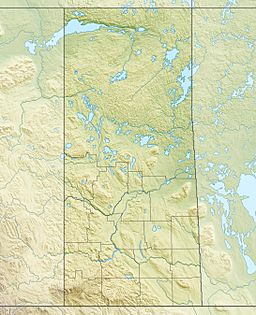Hoidas Lake facts for kids
Quick facts for kids Hoidas Lake |
|
|---|---|
| Location | Saskatchewan |
| Coordinates | 59°55′41″N 107°49′12″W / 59.928°N 107.820°W |
| Basin countries | Canada |
Hoidas Lake is a special lake located far north in Canada. It's about 50 kilometers (31 miles) north of Uranium City, Saskatchewan. This lake is named after Irvin Frank Hoidas, a brave pilot from the Royal Canadian Air Force. He sadly passed away during the Second World War when his plane crashed. Today, Hoidas Lake is known as the site of Canada's most advanced project for mining rare-earth elements (REEs).
Contents
Where Hoidas Lake Is Located
Hoidas Lake is found in a geological area called the Northern Rae Geological Province. This area is known for having many large uranium mines in Saskatchewan. It's a place where important rocks and minerals are found deep underground.
What Minerals Are Found Here?
The rare-earth minerals at Hoidas Lake are special because they are found in veins. These veins are like cracks in the rock filled with minerals such as apatite and allanite.
What makes Hoidas Lake even more unique is that it has a lot of "heavy" rare-earth elements. One important example is dysprosium. These heavy rare earths are very important for making high-tech products. For instance, dysprosium is used in parts for hybrid cars.
Scientists believe these minerals formed from hot, mineral-rich water deep inside the Earth. The main rocks around the minerals are called monzogranite and gneiss. These rocks are very old, dating back to the Palaeoproterozoic and Archaean eras.
How Much Rare Earth Is There?
Exploration work at Hoidas Lake has found a system of mineral veins. This system, called the JAK zone, stretches for at least one kilometer (0.6 miles). Scientists are still working to find out how far it goes in all directions.
The main area with minerals is about 75 meters (246 feet) wide. Inside this area, there are individual veins that can be from one to eleven meters thick. On average, each vein is about three meters (10 feet) thick. These veins go down to a depth of 300 meters (984 feet). They also branch out like tree roots.
Based on current estimates, Hoidas Lake has at least 286,000 tonnes of rare-earth ore. This is a huge amount! It could supply more than 10% of the rare-earth market in North America for many years to come.
Who Owns the Claims?
The mining claims at Hoidas Lake are owned by a company called Great Western Minerals Group. This company is based in Saskatoon, Saskatchewan.


